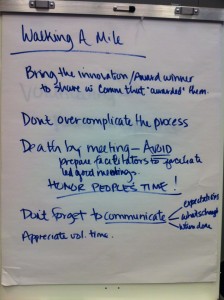From the new Spark whitepaper, The Mission Driven Volunteer, written with Peggy Hoffman:
The Maryland Association of CPAs realigned all their volunteer roles along a grid where the X-axis represented high value to members and the association and the Y-axis represented alignment to strategy. Then volunteer teams used that grid to pull resources away from committees and chapters doing low priority work and refocus those resources on activities and projects that were in the high-high quadrant. This eventually ushered in a complete governance restructuring, including a leaner Board and a reorganized staff, and a shift in the organizational philosophy of volunteering.
The National Fluid Power Association reorganized their volunteer program to focus on engaging members in ideation, development, and delivery of new programs, products, and services that aligned with the strategic direction of the association, and doing that efficiently and in a way that would break out of the traditional hierarchical organization chart. This resulted in a new volunteer structure that allows anyone who wants contribute to do so at the level that fits the needs of that individual volunteer, with strategic communications flowing out and level of engagement flowing in.
The Oncology Nursing Society completely revamped their governance model to be based on the principles of adhocracy, which replaces bureaucratic structure with an organic entity that thrives on decentralizing work and responsibility, and capitalizes on the involvement of many different voices. In the end, only two standing committee remain (Nominating and Audit). The rest of the volunteer work of the association is done by task forces who come together, do the work, and disband.
Want more? Download your free copy at http://bit.ly/13Wwe1F.
